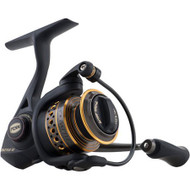TACKLE TUESDAY - SELECTING A REEL
Posted by Heather James on 13th Mar 2018
Last week we talked about how to select the right rod so it only makes sense to tackle how to select the right reel this week. Like I mentioned last week, there is no right answer and a lot of times, gear selection is up to your personal preference. Spinning reels are typically the choice for many surf anglers. Conventional reels are also popular but are typically used by those with a good deal of experience as they are more difficult for those who are new to the surf fishing.
Reel bodies can be made of graphite or aluminum, or sometimes a combination of both. Aluminum housing is stronger than graphite however, graphite is lighter. Deciding whether strength or weight is more important is ultimately a personal choice but keep in mind that graphite is much more corrosion-resistant. Corrision-resistant does not mean you can dunk it in the salt water or lay it down in the sand, you still need to buy a sand spike and rinse the reel! Take care of your gear!
When selecting a spinning reel, you need to know a few key terms:
- Reel Size - 2000, 3000, 20, 25, 30 etc. - Many people are confused by this, but don't be. Each manufacturer rates their reels differently so there is no standard naming convention in the industry. The smaller the model number the smaller the reel. For example, if a manufacturer numbers their reels 2000, 3000, 4000 the 2000 is the smallest. If a manufacturer numbers their reels 20, 30, 40, the 20 is the smallest. You want to select a reel that is appropriate for your rod size, typical rule of thumb is that you should use a 30 or 3000 series on a 6-7' rod, 40 or 4000 series on a 8-9' rod, 50 or 5000 on a 10-11' rod and a 60 or 6000 on a 12' rod.
- Line Capacity - this is the amount of monofilament or braid the reel spool can hold. The size line you should use depends on the type of fish you are targeting and what your rod can handle. If you are targeting larger fish, you will want to use heavier line and need a reel with a larger capacity so that when the big one hits, he can take out plenty of line without spooling your reel!
- Gear Ratio - The gear ratio of a reel will determine how fast you will be able to retrieve line, and how much cranking power you have. The numbers are simple to understand. The first number indicates how many times the spool will turn for every crank of the reel's handle. Therefore, the spool of a reel with a 6.3:1 ratio will turn around 6.3 times for every turn of the reel's handle. Reels with a ratio of 5.5:1 to 6.3:1 are considered fast retrieve reels and work great for casting and retrieving metal lures such as stingsilvers when the spanish mackeral and blue fish are running. If you need more cranking power, to help you reel in a big drum, choose a reel with a lower ratio, like 4.1:1.
- Ball Bearings - Spinning reels feature ball bearings within the body for smoothness, support and stability. Generally speaking, the greater number of bearings a reel contains, the smoother the reel will perform.
At the end of the day, one of the biggest deciding factors is comfort, you want to select a reel that work best for your rod and the fish you are trying to target but comfort is very important. After all, you don't want a sore hand after a day of fishing because you will hopefully have some fish to clean when you get home!
We have a wide variety of reels to choose from, a couple of our favorites are the Penn Battle for drum fishing, Okuma Trio for spanish mackeral and if you are ready for a conventional reel, the Akios 656 or 666.

.png)
.jpg)











